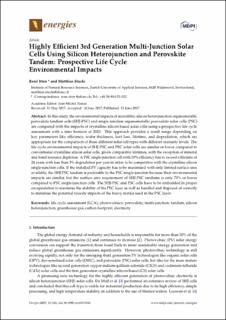Bitte benutzen Sie diese Kennung, um auf die Ressource zu verweisen:
https://doi.org/10.21256/zhaw-1314| Publikationstyp: | Beitrag in wissenschaftlicher Zeitschrift |
| Art der Begutachtung: | Peer review (Publikation) |
| Titel: | Highly efficient 3rd generation multi-junction solar cells using silicon heterojunction and perovskite tandem : prospective life cycle environmental impacts |
| Autor/-in: | Itten, René Stucki, Matthias |
| DOI: | 10.21256/zhaw-1314 10.3390/en10070841 |
| Erschienen in: | Energies |
| Herausgeber/-in des übergeordneten Werkes: | Nunzi, Jean-Michel |
| Band(Heft): | 10 |
| Heft: | 7 |
| Seite(n): | 1 |
| Seiten bis: | 18 |
| Erscheinungsdatum: | 23-Jun-2017 |
| Verlag / Hrsg. Institution: | MDPI |
| ISSN: | 1996-1073 |
| Sprache: | Englisch |
| Schlagwörter: | LCA; Life Cycle Assessment; Prospective; Photovoltaics; PV; Multi-junction; Perovskite; Silicon heterojunction; Tandem; Electricity; Greenhouse gas emission; Carbon footprint |
| Fachgebiet (DDC): | 621.3: Elektro-, Kommunikations-, Steuerungs- und Regelungstechnik |
| Zusammenfassung: | In this study, the environmental impacts of monolithic silicon heterojunction organometallic perovskite tandem cells (SHJ-PSC) and single junction organometallic perovskite solar cells (PSC) are compared with the impacts of crystalline silicon based solar cells using a prospective life cycle assessment with a time horizon of 2025. This approach provides a result range depending on key parameters like efficiency, wafer thickness, kerf loss, lifetime, and degradation, which are appropriate for the comparison of these different solar cell types with different maturity levels. The life cycle environmental impacts of SHJ-PSC and PSC solar cells are similar or lower compared to conventional crystalline silicon solar cells, given comparable lifetimes, with the exception of mineral and fossil resource depletion. A PSC single-junction cell with 20% efficiency has to exceed a lifetime of 24 years with less than 3% degradation per year in order to be competitive with the crystalline silicon single-junction cells. If the installed PV capacity has to be maximised with only limited surface area available, the SHJ-PSC tandem is preferable to the PSC single-junction because their environmental impacts are similar, but the surface area requirement of SHJ-PSC tandems is only 70% or lower compared to PSC single-junction cells. The SHJ-PSC and PSC cells have to be embedded in proper encapsulation to maximise the stability of the PSC layer as well as handled and disposed of correctly to minimise the potential toxicity impacts of the heavy metals used in the PSC layer. |
| URI: | http://www.mdpi.com/1996-1073/10/7/841 https://digitalcollection.zhaw.ch/handle/11475/1321 |
| Volltext Version: | Publizierte Version |
| Lizenz (gemäss Verlagsvertrag): | Lizenz gemäss Verlagsvertrag |
| Departement: | Life Sciences und Facility Management |
| Organisationseinheit: | Institut für Umwelt und Natürliche Ressourcen (IUNR) |
| Enthalten in den Sammlungen: | Publikationen Life Sciences und Facility Management |
Dateien zu dieser Ressource:
| Datei | Beschreibung | Größe | Format | |
|---|---|---|---|---|
| Itten-2017-LCA-Multijunction-PV.pdf | 1.62 MB | Adobe PDF |  Öffnen/Anzeigen |
Zur Langanzeige
Itten, R., & Stucki, M. (2017). Highly efficient 3rd generation multi-junction solar cells using silicon heterojunction and perovskite tandem : prospective life cycle environmental impacts. Energies, 10(7), 1–18. https://doi.org/10.21256/zhaw-1314
Itten, R. and Stucki, M. (2017) ‘Highly efficient 3rd generation multi-junction solar cells using silicon heterojunction and perovskite tandem : prospective life cycle environmental impacts’, Energies. Edited by J.-M. Nunzi, 10(7), pp. 1–18. Available at: https://doi.org/10.21256/zhaw-1314.
R. Itten and M. Stucki, “Highly efficient 3rd generation multi-junction solar cells using silicon heterojunction and perovskite tandem : prospective life cycle environmental impacts,” Energies, vol. 10, no. 7, pp. 1–18, Jun. 2017, doi: 10.21256/zhaw-1314.
ITTEN, René und Matthias STUCKI, 2017. Highly efficient 3rd generation multi-junction solar cells using silicon heterojunction and perovskite tandem : prospective life cycle environmental impacts. Jean-Michel NUNZI (Hrsg.), Energies [online]. 23 Juni 2017. Bd. 10, Nr. 7, S. 1–18. DOI 10.21256/zhaw-1314. Verfügbar unter: http://www.mdpi.com/1996-1073/10/7/841
Itten, René, and Matthias Stucki. 2017. “Highly Efficient 3rd Generation Multi-Junction Solar Cells Using Silicon Heterojunction and Perovskite Tandem : Prospective Life Cycle Environmental Impacts.” Edited by Jean-Michel Nunzi. Energies 10 (7): 1–18. https://doi.org/10.21256/zhaw-1314.
Itten, René, and Matthias Stucki. “Highly Efficient 3rd Generation Multi-Junction Solar Cells Using Silicon Heterojunction and Perovskite Tandem : Prospective Life Cycle Environmental Impacts.” Energies, edited by Jean-Michel Nunzi, vol. 10, no. 7, June 2017, pp. 1–18, https://doi.org/10.21256/zhaw-1314.
Alle Ressourcen in diesem Repository sind urheberrechtlich geschützt, soweit nicht anderweitig angezeigt.